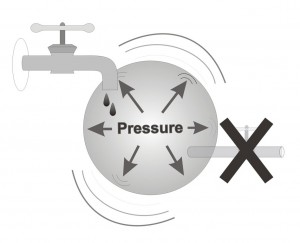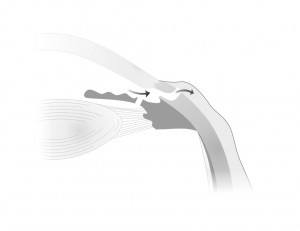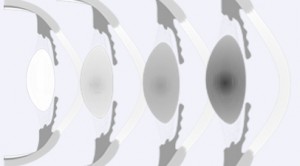It is not good news for a person who never wore glasses their entire life, to suddenly, some point between the ages of 44 and 47, “giving in” and visiting an optometrist complaining that he/she can no longer see objects that are nearby in focus, and that he has difficulty reading small letters, particularly for an extended period of time. Reading becomes difficult, and even simple actions such as looking at the “received call” number on the cellular phone or reading information from a hand held device become nearly impossible. What is most dramatic is the fact that this problem has existed for well over a year and until now the person, with great difficulty, managed to bypass the problem. But now, it has become extremely bothersome and disturbing to continue managing this way.
This descriptive explanation serves as an introduction to a problem that, unfortunately, will affect each and every person starting around 45, and will gradually worsen until reaching a plateau somewhere around the age of 60-70. As frustrating as it may be, worsening of eyesight for objects that are near (presbyopia) is not categorized by doctors as an illness, but rather as a universal, age-dependent change that every person undergoes. Paradoxically, this process is the hardest and most frustrating for those who never required glasses before reaching this age.
If so, what is this odd change that people undergo at this relatively calm time of their life (after all, the mid-life crisis of age 40 is already behind them)? Well then, I will begin by directing you to the section on presbyopia. If you have not yet read this section, feel free to click on the blue link which you have just read.
So, what exactly happens at this age that no longer allows us to see near objects clearly? My answer is as follows: In order to be able to see clearly both near and far, the eye must change its focus. This adjustment is accomplished by the lens that each of us has in his/her eye. This lens is capable of, in response to a command from the brain, changing shape by contracting delicate circular muscles that are found within the eye. Over time, the lens loses its flexibility, and therefore, its ability to change shape. In spite of the brain sending out a ‘focusing’ command, and the muscles obeying this command and constricting, the lens refuses to change shape owing to hardening (stiffening) of its material. This loss of elasticity is gradually translated into less and less ability to focus on objects that are near, for extended periods of time. Fatigue also appears in the context of the ongoing attempt to fully contract the circular muscle mentioned above, especially when focusing for near for an extended time period (such as when reading a book). It is interesting to note that while difficulty reading appears as of age 45, trouble working at a computer appears only many years later. This is because of the simple fact that the distance between one’s eyes and the computer is approximately 50-60 cm, whereas the normal distance when reading is much shorter, around 35-40 cm. With advancing age it becomes harder and harder to focus on objects that are near, so that around the ages of 60-70 it will even be difficult to see objects that are a meter away clearly, without the aid of reading glasses.
After this thorough explanation you have, most likely, become convinced, that the problem will not disappear on its own, and there is no choice but to visit an optometrist (who can be found in glasses stores) to be fitted for reading glasses. For those of you who already wear glasses in order to see distant objects, this is a less significant change, and therefore easier to become accustomed to it. For those of you who never wore glasses, it is not an easy change to get used to, and the curiosity of those around you most likely doesn’t help in keeping the change low key.
I will briefly describe what you will encounter during the visit to an optometrist: You will undergo an eye-exam to test your vision, both for near and for far (by reading numbers that get progressively smaller, with one eye at a time closed). Following that, you will be fitted with glasses that contain the correct refraction for your eyes. This exam will place different powered lenses in front of each of your eyes in an attempt to find the optimal balance between sharp vision for objects that are near, as well as comfort which is expressed as the ability to read for extended periods of time with a minimum of fatigue.
At the end of the exam, which will last approximately half an hour, the proper refraction for your glasses will be determined and then you will begin the step of choosing a frame. Finally, a new pair of glasses will be ordered for you. When you wear them for the first time the world will appear much clearer for objects that are close by, and suddenly, your arms will no longer “feel too short” (a feeling connected to the fact that those who require reading glasses but who refrain from wearing them, hold reading material as far as possible from their eyes, in order to improve clarity).
However, this is just the beginning of the process, since it not comfortable or practical to put on and take off reading glasses every time one wants to know the time, or look at their smart phone. It is amazing to feel for the first time, just how many times we look for a fraction of a second at something that is near by, and it becomes clear that it is not practical to replace and remove glasses 300 times a day.
If so, what can be done? The most obvious, though not the most fashionable, answer is to wear “half” glasses that are worn under the line of sight and therefore one looks through them only when gazing down. Other options include bi-focal and multi-focal glasses, which are much more in style, but also much more expensive (with multifocals being far more expensive than bifocals). These combination lenses are perfect for people who want to wear glasses all the time, and therefore no longer need to remove and replace the glasses countless times a day. My recommendation is to start with a pair of regular reading glasses, that in the future will become the secondary pair of glasses that one keeps in your bedroom for reading before going to sleep. At the same time, you can begin looking into the other options for glasses that will be more practical on a day to day basis.
A few tips about choosing a pair of reading glasses:
1. There are large differences in the price of reading glasses in different stores, especially when it comes to multifocal lenses. It is worthwhile and greatly recommended to compare prices. Additionally, by checking in a few different stores, you increase the number of frames from which you can choose.
2. It is possible, and even wise, to start with a simple (cheaper) pair of glasses and then continue to compare prices regarding a permanent pair. This will still remain your main pair for comfortable reading that you will enjoy when reading for extended periods of time (such as in bed, before going to sleep).
3. It is important to remember that the power of the glasses (also called refraction) will get progressively stronger, so that every 4-5 years, it will be necessary to change the lenses for a slightly stronger prescription. This escalation in the power of the prescription plateaus at the age of 65-70, but that is still a very long way to go, and who knows what science will invent for us by then.
4. In conclusion, the most significant change in your lives in connection to reading glasses is a combination of two things: The dependence that is generated on one’s reading glasses, without which it becomes difficult to function on a daily basis, a feeling of dependency which you may have not experienced until now. This dependency often leads to feelings of frustration and anger about the fact that we are not the people that we used to be. However, there is nothing to be done, time will help and there is no choice but to get used to this new situation. The second, more complicated, topic is connected to the fact that suddenly everyone sees your reading glasses (for it is impossible to hide them) and this makes a statement and attracts attention that most of us would be happy to do without. Here too, anger and sadness will not help, and one simply has to “jump into the water” and be comforted by the fact that all of your contemporaries are feeling the same need for reading glasses, even if not all are willing to acknowledge it publicly.
Following this long explanation, and particularly the discussion of some emotionally sensitive points in the previous paragraph, there is nothing left to be done for those of you who feel difficulty reading things that are close, and are past the age of 45, but to go to an optical store and inquire about the need, and be tested for your first pair of reading glasses. One final sentence in conclusion, if you have not had an ophthalmological exam in the past year or two it is advisable to schedule such an appointed in order to ensure that aside from the necessity for reading glasses, everything else is fine and that there are no signs of problems or diseases of any sort. While an optometrist’s exam is focused on the optical aspects of the eye, the ophthalmologist’s examination analyses the different components of the eye from a health standpoint, ruling out diseases and illnesses that your eyes may be at risk for. In general, identifying such problems early on is critical and often implies that health can be restored, or at least future deterioration can be significantly slowed down.



